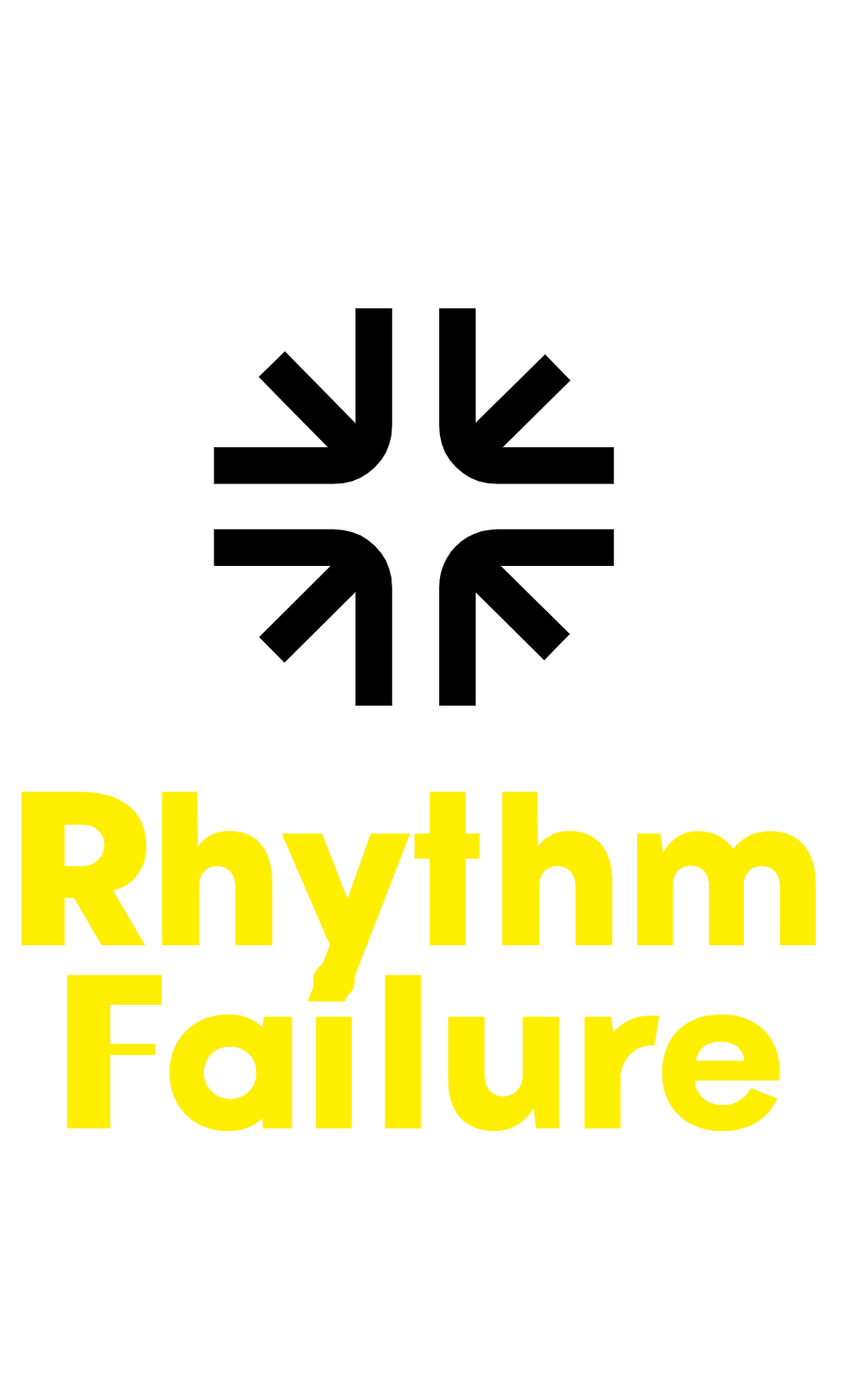Music Career Tips
The Ultimate Guide to Selling My Lyrics for Songs
Intrigued about selling your lyrics for songs? Uncover insider tips and tricks to navigate the music industry like a pro in this comprehensive guide.

So, you're ready to immerse yourself in the world of selling your lyrics for songs, huh? Well, let's break it down for you! First off, it's all about networking in this industry. Get cozy with fellow creatives for collaborations and growth opportunities. Don't forget to sign those publishing deals to kickstart your journey! And hey, performance rights organizations are your besties for ensuring those royalties keep rolling in. But wait, there's more juicy info waiting for you. Keep exploring to unravel the secrets to selling your lyrical masterpieces in this enchanting musical domain.
Key Takeaways
- Network with industry professionals for collaboration opportunities.
- Pitch songs to music publishers and record labels for exposure.
- Join PROs to ensure royalties for your songwriting.
- Protect your work through copyright registration and trademarking.
- Utilize social media and contests to market your lyrical creations.
Understanding the Songwriting Industry
When delving into the domain of the songwriting industry, it becomes evident that networking plays a pivotal role in fostering collaborations and seizing opportunities for growth and success. Songwriters, those magical wordsmiths who weave tales with melody in the backdrop, often kickstart their journey by signing publishing deals. These deals are like golden tickets to the chocolate factory of music, granting exposure and a shot at success.
Music publishers and record labels are the guardians of these golden tickets, helping songwriters navigate the tricky terrain of promotion and distribution. Think of them as the fairy godmothers and godfathers of the music world, waving their wands to make sure your tunes reach the right ears.
Performance rights organizations are like the superheroes behind the scenes, ensuring that songwriters get their well-deserved royalties when their masterpieces are played. So, dear readers, remember this intricate dance between songwriters, music publishers, record labels, performance rights organizations, and those oh-so-crucial publishing deals—it's the recipe for making musical magic happen!
Key Players in the Songwriting Business

In the dynamic world of the songwriting business, key players such as songwriters, music publishers, record labels, performance rights organizations (PROs), and producers collaborate to bring musical creations to life. Songwriters are the creative geniuses behind the lyrics and melodies that captivate us, while music publishers work their magic to guarantee that those tunes are out there for everyone to enjoy. Record labels are like the fairy godmothers of the industry, making dreams come true for artists by managing the production and distribution of their music. PROs guarantee that songwriters get their well-deserved royalties whenever their songs are performed in public. And let's not forget about the producers who sprinkle their special touch on songs, turning them into hits that we can't help but groove to.
| Key Players | Description |
|---|---|
| Songwriters | Create the magic with lyrics and melodies. |
| Music Publishers | Promote and distribute songs to artists and users. |
| Record Labels | Sign artists and oversee music production and distribution. |
| Performance Rights Organizations | Collect royalties for public performances of songs. |
| Producers | Shape the final sound of a song, working with songwriters and artists. |
Crafting Marketable Song Lyrics
Crafting marketable song lyrics is all about reeling in your audience with catchy hooks that stick in their minds like a catchy jingle on repeat.
Emotionally resonant verses make listeners feel a connection to the music, while memorable chorus lines guarantee they keep coming back for more.
Striking that perfect balance between commercial appeal and artistic expression is the secret sauce for creating lyrics that captivate and leave a lasting impact on the music scene.
Catchy Hook Creation
Let's explore the art of creating irresistibly catchy hooks that draw listeners in and leave a lasting impact. Crafting a memorable song is like baking a delicious cake – you need that perfect hook to be the sweet icing on top.
By infusing storytelling elements into your song lyrics, you transport your audience into a world where they can't help but hit the replay button. Remember, striking a balance between commercial appeal and artistic integrity is key.
Think of your catchy hook as the flashy storefront of a trendy shop; it needs to attract attention while hinting at the treasures inside. So, aim for a hook that sticks in people's minds like a catchy jingle, making your song an instant favorite.
Emotionally Resonant Verses
How can emotionally resonant verses elevate the impact of song lyrics and connect deeply with listeners?
Well, envision this: you're at one of those hip songwriting workshops, pen in hand, ready to craft the next big hit.
By weaving storytelling into your lyrics, you create a tapestry of emotions that resonates with your audience. It's like painting a vivid picture with words, drawing them in and making them feel something real.
Finding that pivotal balance between artistic expression and commercial viability is essential. You want your verses to be catchy hooks that stick in people's minds, making your song unforgettable.
Memorable Chorus Lines
When aiming to create memorable chorus lines in song lyrics, our focus should be on crafting phrases that resonate deeply with listeners and linger in their minds long after the music fades.
A killer chorus is like a catchy jingle for the soul, sticking in your brain like a delicious earworm. To make a chorus line truly unforgettable, infuse it with emotional impact that hits you right in the feels.
Think about those songs that make you want to belt out the chorus at the top of your lungs; that's the power of a well-crafted chorus line. Balancing commercial appeal with genuine emotion is key to creating a chorus that not only sells but also connects with people on a deeper level.
Protecting Your Intellectual Property

Alright, folks, let's get real about protecting your intellectual property when it comes to your song lyrics. Copyright laws are like your songs' bodyguards, making sure your creative genius is safe and sound.
Don't forget to trademark your work to really put your stamp on it and show the world it's yours. And remember, taking legal protection steps is like putting a shield around your lyrical masterpieces, keeping them safe from any shady business.
Copyright for Lyrics
Copyright laws protect songwriters' ownership rights of their lyrics, ensuring legal safeguards for their intellectual property. When it comes to protecting your lyrical masterpieces, registration is your best friend. It serves as concrete evidence of your ownership, giving you a solid foundation to defend your creative genius. Understanding the ins and outs of intellectual property law is like having a secret weapon in your lyrical arsenal. Consult with an intellectual property lawyer to navigate the intricacies of copyrighting your lyrics like a pro. By registering your work, you're building an invisible fortress around your songs, shielding them from any shady characters looking to steal your spotlight. Stay ahead of the game by locking in that copyright protection!
| Benefits of Copyright for Lyrics | Importance of Registration | Legal Protection |
|---|---|---|
| Proof of Ownership | Basis for Claims | Prevents Plagiarism |
Trademark Your Work
To safeguard our creative works and maintain control over our intellectual property, trademarking our lyrics is crucial. As artists, we pour our hearts and souls into crafting those perfect words that resonate with the world.
By trademarking our lyrics, we not only protect our rights but also create a solid record of ownership. This legal safeguard guarantees that we can make money from our creations without the fear of unauthorized use.
Trademarking adds that extra layer of security, giving us the peace of mind to continue creating without worrying about someone else swooping in and stealing our genius. So, let's take that step, trademark our work, and pave the way to a profitable and secure future in the music industry!
Legal Protection Steps
Let's take proactive steps to safeguard our intellectual property through legal protection measures. When it comes to protecting your lyrics, understanding international copyright laws is crucial. Registering your songs not only establishes ownership but also serves as a shield against potential infringements. Consulting an intellectual property lawyer might sound fancy, but it's a smart move to guarantee your creative work is legally fortified. Legal protection isn't just about putting up a 'Do Not Enter' sign; it's about securing your rights as a songwriter in this vast musical landscape. Check out the table below for a snapshot of important legal protection steps you can take:
| Legal Protection Steps | Description |
|---|---|
| Registering Songs | Provides proof of ownership |
| International Copyright Laws | Understanding global protection |
| Intellectual Property Lawyer | Expert guidance for legal security |
| Protecting Lyrics | Prevent unauthorized use and secure rights |
Marketing Your Song Lyrics

When marketing song lyrics, we can leverage social media platforms to showcase our work and connect with a larger audience. Social media isn't just for stalking your favorite celebrities or sharing cute cat videos; it's a powerful tool for getting your lyrics out there. Platforms like Instagram, Twitter, and even TikTok can help you reach a wide range of people who might just be looking for the next big hit. So, get creative with your posts, throw in some catchy hashtags, and watch those likes and shares skyrocket!
Another cool way to market your song lyrics is by collaborating with other creative minds. Working with fellow songwriters, artists, or producers can bring fresh perspectives and ideas to the table, making your lyrics even more appealing to potential buyers. Plus, it's a great way to network and build connections in the music industry.
Don't be afraid to pitch your songs to music industry professionals or enter contests and showcases for exposure. Seeking feedback from experts can also help you fine-tune your craft and increase your chances of success. So, put yourself out there, get those lyrics noticed, and who knows? You might just sell the next chart-topping hit!
Approaching Music Producers and Artists

When seeking to collaborate with music producers and artists, building strong connections and relationships is key to successfully selling your lyrics. Networking is like planting seeds in the music industry garden – you never know which one will grow into a beautiful collaboration.
Attending music conferences and events is a fantastic way to mingle with potential collaborators and showcase your lyrical prowess. Social media isn't just for memes and cat videos; it's a powerful tool for engaging with producers and artists. Slide into their DMs (respectfully, of course) and start building those connections.
Collaborating with producers is like a musical blind date – you never know what magic might happen until you give it a shot. By working together, you can create something truly unique that resonates with audiences. Remember, in the world of music, it's all about who you know, so get out there and start pitching your lyrical genius to the world!
How Many Songs Does an EP Have?

Exploring the ideal length for an EP involves considering the number of songs typically included in this shorter musical collection. EPs usually feature 4 to 6 songs, packing a punch in a compact format that leaves us craving more. Artists use EPs as a canvas to showcase their fresh tunes, giving us a taste of their musical genius without overwhelming our playlists. These mini-masterpieces can range from 15 to 30 minutes, making them perfect for a quick jam session or commute groove.
EPs aren't just random song assortments; they serve a purpose. They help artists keep the momentum going between full album releases, keeping fans engaged and hungry for more. Think of EPs as a sneak peek into an artist's creative world, a teaser trailer for the main event. The number of songs on an EP isn't set in stone; it's a strategic choice based on the artist's vision and how they want to captivate their audience. So, next time you hit play on an EP, remember, it's not just a handful of songs—it's a carefully crafted musical showcase.
Expert Q&A

Exploring the world of music industry professionals, we uncover valuable insights and advice through Expert Q&A sessions. Imagine immersing yourself (or leaping into, we don't judge) with seasoned pros who spill the tea on pitching your lyrics like a pro, cozying up to publishers, and making it rain with royalties. They'll school you on the art of building industry relationships – it's like networking, but with more backstage passes and fewer awkward handshakes.
And hey, ever heard of Performing Rights Organizations (PROs)? These are your ticket to the royalty party – don't leave home without one. Our experts will break it down for you, so you can collect those sweet, sweet royalties like a boss.
Oh, and sending demos? Networking at music events? Entering lyric writing contests? Get ready to immerse yourself in the wild world of music biz shenanigans. Our experts have the inside scoop on how to get your foot in the door (or maybe even your whole leg). So buckle up, buttercup, because this Q&A session is about to rock your lyric-selling world!
Frequently Asked Questions
How Do I Sell Songs I Have Written?
Selling songs we've written? It's all about finding our vibe with artists, making killer demos that scream our style, and rubbing elbows with the music crowd to get noticed.
Don't forget to nail those licensing deals for fair pay! Hit up online spots, contests, and events to get our tunes out there.
It's a mix of charm, talent, and knowing the biz, but we're ready to rock it!
How Much Money Do You Get for Selling a Song?
Selling a song can net you a range of cash, depending on factors like the artist's fame and the deal you strike. From upfront payments to royalties, the dough can add up big time, especially if your tune becomes a hit.
Major players might bring in thousands or even millions, while indie vibes could mean lower upfront bucks but potential for future riches. Knowing the music money game is key to maxing out your earnings!
How Do You Make Money off a Song You Wrote?
We make money off a song we wrote by exploring various avenues like securing publishing deals, licensing agreements, and direct sales to fans through CDs, vinyl, digital downloads, or streaming services.
Understanding different deal types, collaborating with others, joining a PRO for royalty collection, and creating high-quality songs are key steps.
How Much Does It Cost to Have a Song Written for You?
When you're looking to have a song written just for you, be prepared for prices ranging from $150 to $2,500. The cost will depend on the songwriter's expertise and the complexity of the song.
Professional songwriters might charge between $500 to $1,000 for high-quality tunes. If you want to collaborate with a well-known artist, be prepared to pay $5,000 or more per song.
For special occasions like weddings, song packages can range from $200 to $1,000. So, if you're ready to invest, grab your wallet and let the music flow!
Conclusion
So there you have it, folks! Selling your lyrics for songs may seem like a challenging task, but with the right knowledge and approach, you can make it happen.
From understanding the industry to protecting your work and marketing it effectively, you now have the tools to succeed.
So go out there, craft those catchy lyrics, and get ready to see your words come to life in the music world. It's time to turn your passion into profit!
Music Career Tips
How to Overlap Songs Like a Pro in 10 Steps
Start mastering the art of overlapping songs with these 10 steps, and watch your DJ skills soar to new heights – the secrets await!
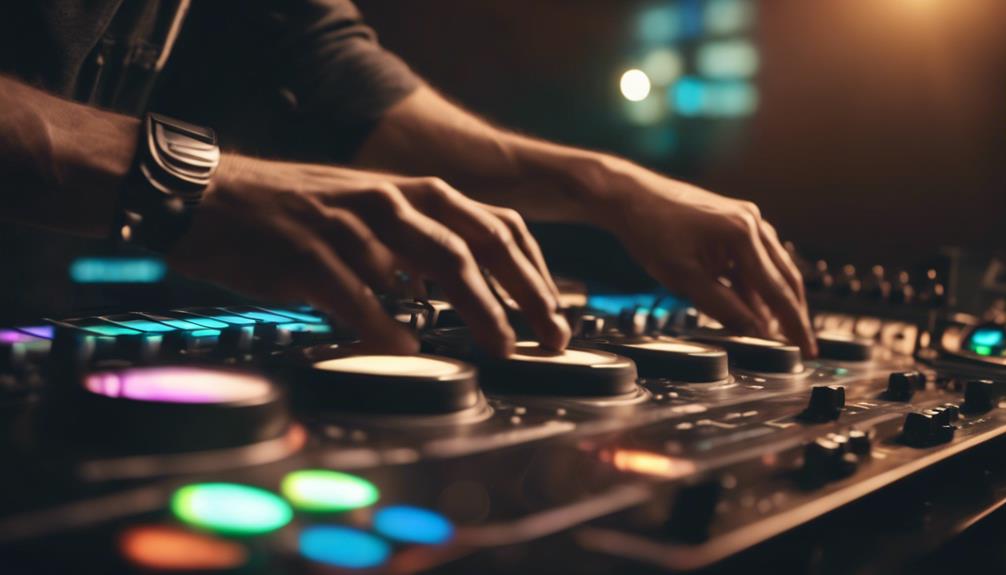
So, you wanna be a pro at overlapping songs? Well, you're in for a treat! Step one, pick tracks that vibe together like peanut butter and jelly – think shared tempos or keys. Next up, nail those cue points for timing perfection, and tweak those beats for seamless sync. Don't forget to fine-tune with pitch control for that extra oomph! Match those beats, blend basslines and melodies like a boss, and keep practicing those overlaps for that pro-level finesse. Sounds exciting, right? Trust us, there's more where that came from!
Key Takeaways
- Set cue points at key sections for smooth transitions.
- Adjust tempo and timing for seamless overlapping.
- Harmonize tracks by aligning keys with pitch control.
- Master EQ mixing to blend frequencies effectively.
- Use filters to overlap basslines and melodies flawlessly.
Select Tracks With Similar Characteristics
When choosing songs to seamlessly blend like a pro, we aim for tracks that share similar tempos, keys, or musical elements. This is where the magic of mixing techniques comes into play. By selecting tracks with these shared characteristics, we set ourselves up for smooth shifts that keep the energy flowing on the dance floor. Imagine a DJ wizard skillfully merging two songs together, creating a musical journey that captivates the audience. That's the power of choosing tracks with compatible tempos and keys – it's like finding the perfect puzzle pieces that fit together flawlessly.
Mixing techniques involve more than just hitting play on two tracks. It's about understanding the intricacies of each song and how they can work together harmoniously. By identifying songs with complementary energy levels and vibes, we can create a mix that feels cohesive and dynamic. Think of it as painting with sound, layering different elements to craft a masterpiece that keeps the crowd grooving all night long. So, the next time you're selecting tracks for your set, remember the importance of mixing techniques and choose wisely for a truly unforgettable musical experience.
Set Cue Points for Timing

Setting cue points for timing is vital in ensuring smooth shifts between songs during a mix. By strategically placing these markers at key sections such as choruses or instrumental breaks, we can hit those shifts with precision, like a musical ninja! These cue points act as our guiding stars, helping us align specific beats or musical elements between tracks seamlessly. It's like having a secret map to navigate the rhythm jungle of mixing.
As we dive deeper into the art of mixing, adjusting cue points becomes essential. Matching them to the tempo and structure of each song guarantees a flawless shift, keeping the groove alive and the crowd on their feet. Think of cue points as your trusty sidekicks, aiding you in synchronizing tracks accurately during live performances. Don't be afraid to experiment with different placements to find that sweet spot where magic happens. With practice and a sprinkle of creativity, you'll master the timing game and overlap songs like a true pro.
Adjust Tempo for Synchronization
Alright, folks, let's talk about adjusting tempo for synchronization like pros!
When you're mixing tracks, matching the BPM is key for that seamless flow everyone loves on the dance floor.
We'll explore tempo matching techniques, beat grid alignment, and tempo automation tools to keep those beats in perfect harmony.
Let's dial in those tempos and get those changes silky smooth!
Tempo Matching Techniques
To achieve seamless synchronization during changes, we adjust the tempo of songs to match, ensuring a harmonious blend of rhythm sections.
When diving into tempo matching, precision is key. Whether using BPM counter tools or your good old noggin for manual calculations, nailing down the tempo of each track accurately sets the stage for a flawless shift.
Aligning beats and phases is like solving a musical puzzle – make sure those rhythm sections are locked in tight. With the magic of tempo sliders on DJ software, tweaking the BPM of both tracks becomes a breeze.
Practice makes perfect, so don't be shy to set those cue points and repeat the process until you're a tempo matching maestro.
Beat Grid Alignment
Ensuring precise synchronization between songs for seamless shifts involves adjusting the beat grid to match tempo and rhythm accurately. When it comes to beat grid alignment, here are some key points to take into account:
- Enhance Flow: Correcting beat grid alignment enhances the overall flow and coherence of your DJ sets, keeping the music seamless and engaging.
- Avoid Clashing Beats: Beat grid alignment helps match the tempo and rhythm of songs, preventing any jarring clashes between beats that could disrupt the vibe.
- Professional Mixing: Utilize software tools for EQ mixing to fine-tune the beat grid, ensuring your beats align perfectly for that polished, professional sound.
- Essential for Mixing: Accurate tempo adjustment through beat grid alignment is essential for flawless shifts, keeping the music flowing smoothly from one track to the next.
- Continuous Music Flow: With precise beat grid alignment, you can maintain a continuous music flow that captivates your audience and keeps them grooving all night long.
Tempo Automation Tools
After aligning the beat grid to guarantee smooth connections between songs, utilizing tempo automation tools becomes essential in adjusting the tempo for synchronization, enabling a seamless overlap and continuous music flow. These tools are like magic wands for DJs, allowing us to tweak the tempo of songs to match perfectly for those epic adjustments.
Imagine this: you're mixing two tracks, and the lead vocal of the incoming song needs to kick in at just the right moment. With tempo automation, you can make sure that the tempo is spot on, making the lead vocal entrance pure perfection. By gradually speeding up or slowing down a song, you can create a mix that keeps the energy flowing and the crowd on their feet.
Tempo automation tools are your secret weapon for crafting unforgettable sets!
Fine-Tune With Pitch Control

Alright, folks, let's chat about tweaking those tunes with pitch control.
This nifty tool lets us dial in the perfect harmony between tracks, ensuring a seamless shift.
With pitch adjustment, we can blend melodies and vocals like a maestro, keeping those clashes at bay for a polished mix.
Pitch Adjustment Techniques
To fine-tune songs seamlessly during overlap shifts, utilizing pitch control features in DJ software is essential for adjusting the pitch with precision. When it comes to pitch adjustment techniques, here are some innovative ways to elevate your mixing game:
- Experiment with subtle pitch adjustments for a gradual shift.
- Explore the world of harmonic mixing for a seamless blend of keys.
- Master the art of matching pitches to create a cohesive flow between tracks.
- Use pitch control creatively to surprise your audience with unique changes.
- Practice precision in adjusting pitch to guarantee professional and polished overlaps.
Understanding these techniques will take your DJ skills to the next level, creating unforgettable musical journeys for your listeners.
Harmonize Overlapping Tracks
Using pitch control to fine-tune overlapping tracks is essential for achieving seamless harmonization in your mixes. By adjusting the pitch of each track to match key elements, you can create a smooth shift that captivates your audience. Experimenting with slight pitch variations adds depth and interest to the overlapping sections, elevating your overall sound. It's vital to make sure that the pitch adjustments not only enhance the mix but also maintain consistency between tracks. Practice blending tracks with pitch control to master the art of harmonizing overlapping songs like a pro.
| Pitch Control Tips | Description |
|---|---|
| Match Key Elements | Adjust pitch to align with key elements. |
| Experiment with Variations | Try slight pitch changes for added depth. |
| Maintain Consistency | Ensure pitch adjustments keep tracks cohesive. |
| Enhance Overall Mix | Use pitch control to elevate the entire mix. |
| Practice Makes Perfect | Keep practicing to master harmonization. |
Align Beats and Transitions

For smooth song changes, it's vital to align beats accurately by matching tempo and phase precisely between tracks. When shifting between songs, ensuring that the beats are aligned is like the secret ingredient that takes your mix from good to mind-blowing. Here are some tips to help you nail those shifts and keep the party going:
- Cue Points: Mark those key sections in your tracks so you can effortlessly jump from one to the other, creating a seamless flow that keeps the energy high.
- Gradual Tempo Adjustments: Slide those tempo controls like a pro chef adding just the right amount of seasoning, slowly syncing up the beats for a smooth shift.
- Fine-Tune the Mix: Listen carefully for any clashes or inconsistencies in the mix. It's like being a detective, hunting down any sneaky sounds that don't quite fit.
- Practice Makes Perfect: Mastering beatmatching techniques takes practice, so keep at it. Soon you'll be overlapping songs flawlessly, impressing your audience with your seamless shifts.
- Innovate and Experiment: Don't be afraid to try new things and push the boundaries of traditional mixing. Innovation is key to keeping your sets fresh and exciting.
Utilize EQ Mixing Techniques

Alright, so let's delve into EQ mixing techniques – this is where the magic happens, folks!
We're exploring those frequencies, making sure each instrument and vocal gets its time to shine. Remember, high-pass filters are your friends, keeping those low frequencies in check for a clean sound.
And don't forget to cut and boost strategically, giving each element its own space in the mix.
Let's immerse ourselves in the nitty-gritty of EQ and make those songs overlap like a pro!
EQ Frequency Adjustment
To enhance the clarity and separation of instruments in a mix, mastering the art of EQ frequency adjustment is essential. When diving into EQ mixing techniques, remember these key points:
- Create Space: EQ mixing involves adjusting frequency levels to create space for each instrument or vocal in the mix.
- Precision Boosts: Use parametric EQ to precisely boost or cut specific frequencies for clarity and separation.
- Rumble Removal: High-pass filters can remove low-end rumble and muddiness from non-bass instruments.
- Taming Highs: Low-pass filters help tame harsh high frequencies in instruments like cymbals or hi-hats.
- Masking Solutions: Notching out problematic frequencies can resolve masking issues between instruments for a cleaner mix.
Mastering these techniques will take your mixing skills to a whole new level!
Balancing Sound Levels
Let's optimize the sound levels by leveraging EQ mixing techniques to achieve a well-balanced mix. When it comes to balancing sound levels, EQ is our trusty sidekick. We're talking about sculpting the sonic landscape, ensuring each instrument and vocal has its own space to shine.
By diving into those EQ settings, we can dodge those pesky clashes between frequencies and make sure every element gets its time in the spotlight. It's like being a sound sculptor, chiseling away to reveal the perfect tonal balance for a harmonious blend.
With a bit of EQ band wizardry, we can enhance clarity, giving each part its moment to strut its stuff. So, are you ready to EQ like a pro and make sure your mix is as balanced as a gymnast on a tightrope?
Harmonic Overlapping Techniques
As we fine-tune the sound levels using EQ mixing techniques, we seamlessly integrate harmonic overlapping to create a cohesive blend between tracks.
When it comes to harmonizing songs like a pro, here's what you need to do:
- Carve out frequency space: Make sure each track has its own sonic territory.
- Identify overlapping frequencies: Find where tracks clash and resolve it.
- Utilize high-pass and low-pass filters: Smoothly blend different tracks.
- Apply notch filters: Clear up any frequency clashes for a crisp sound.
- Experiment with EQ boosts and cuts: Enhance the overall mix and keep it clean.
With these techniques, your music will sound seamless and professional, ensuring an engaging listening experience.
Blend Basslines and Melodies
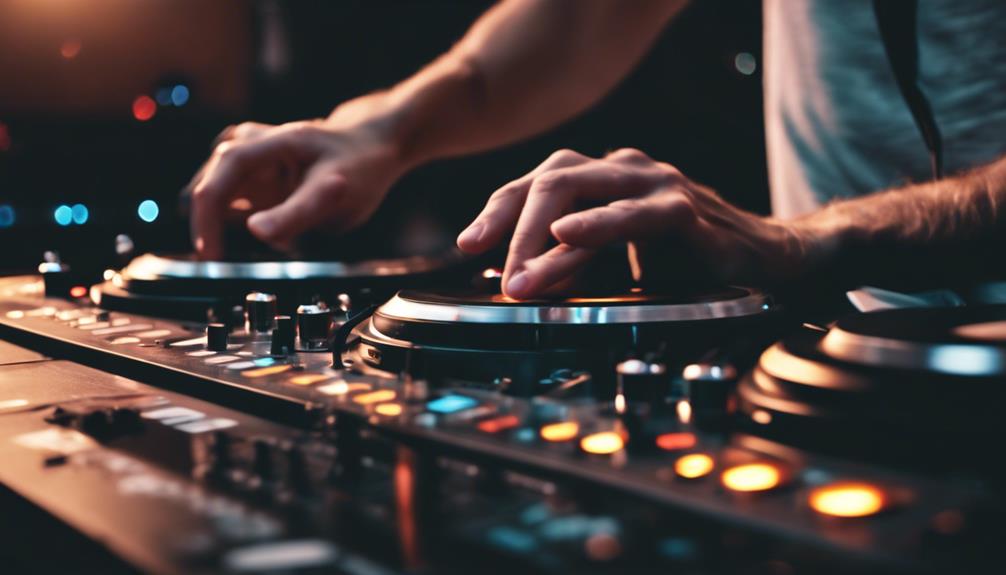
When blending basslines and melodies in overlapping songs, guarantee harmonious coexistence by maintaining them in key to preserve musical coherence and prevent clashes. Imagine your basslines as the sturdy foundation of a musical skyscraper, holding everything together with their deep, resonant tones. To guarantee a seamless blend, make sure the basslines of both songs are in harmony. Adjust the volume levels carefully, balancing the low-end frequencies to avoid a muddy mix that'll leave your listeners scratching their heads.
Don't forget about the magic of EQ! Carve out space for each song's bassline, allowing them to dance around each other without stepping on toes. Experiment with different EQ settings and compression techniques to create a symphony of sound that'll make your audience's ears perk up with delight. And for an extra touch of pizzazz, try some sidechain compression on one song's bassline to give it a pulsating heartbeat that complements the melodies of the other. With these tricks up your sleeve, your basslines and melodies will blend together like a match made in musical heaven.
Practice Seamless Overlaps
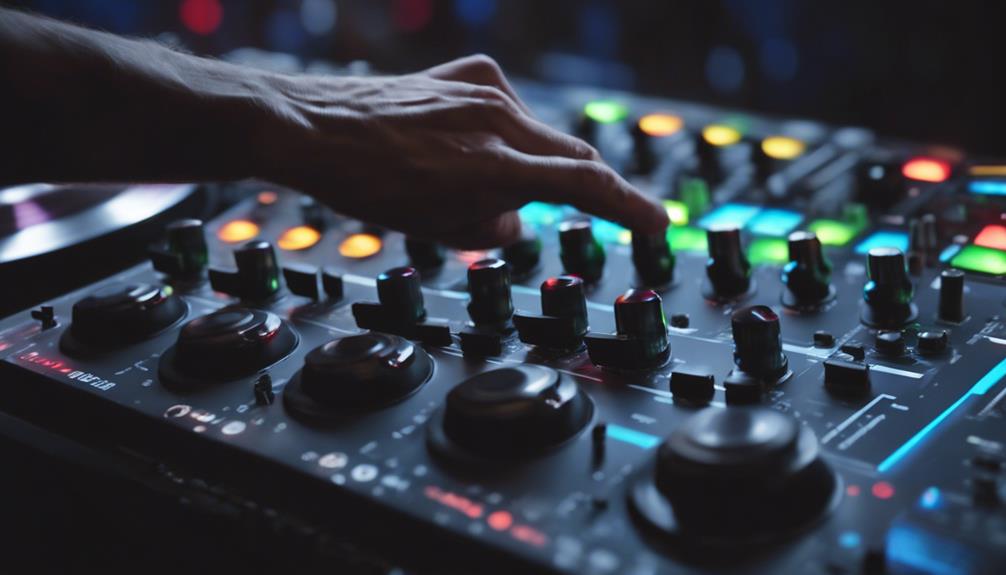
To achieve flawless shifts between songs, focus on honing your skills in seamlessly overlapping tracks with precision and finesse. It's all about the smooth handoff, like butter melting on a hot pancake.
Here's how to level up your game in practice seamless overlaps:
- Feel the Beat: Get in sync with the rhythm of each track, let it flow through you.
- Mark Your Spot: Use cue points like a treasure map, guiding you to the perfect handoff.
- Blend Like a Pro: Gradually adjust those tempo sliders, mixing the beats like a DJ chef.
- Sync and Swim: Dive deep into the rhythmic patterns, aligning beats for a seamless swim between tracks.
- Repeat, Repeat, Repeat: Practice makes perfect, so keep at it until those handoffs are smoother than a freshly paved road.
With these tricks up your sleeve, you'll be overlapping songs like a pro in no time. Keep practicing those seamless handoffs, and soon you'll be mixing tracks like a seasoned DJ.
Repeat for Mastery
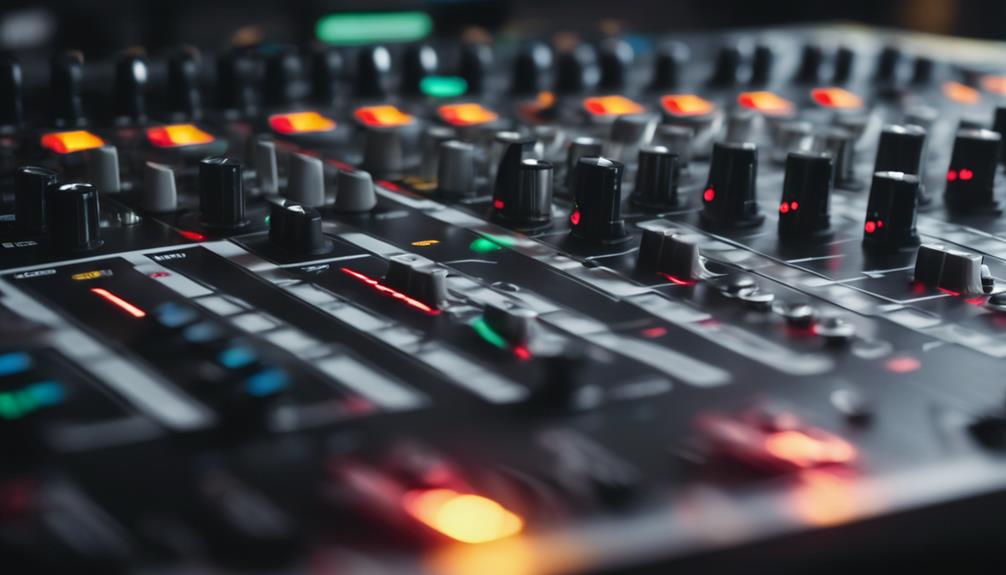
Let's solidify our mastery of overlapping songs by embracing consistent repetition as the key to honing our smooth switches. The more we practice overlapping songs, the more we enhance our ability to seamlessly blend different tracks like a pro. It's all about those fluid switches that leave your audience in awe. Remember, repetition is not just about going through the motions; it's about refining our technique with each iteration.
To help visualize the importance of repeating for mastery, let's break it down into a handy table:
| Benefits of Repeating Overlaps | Description | Outcome |
|---|---|---|
| Improved Switching Skills | Enhances blending abilities | Seamless song switches |
| Enhanced Professional Style | Develops a polished technique | Pro-level overlapping prowess |
| Confidence Boost | Reinforces skills | Bold and flawless performances |
Achieve Pro-Level Overlaps

We enhance our skills by implementing beatmatching techniques for smooth blending between songs, guaranteeing a professional and polished overlapping experience. To achieve pro-level overlaps, we must start utilizing key and energy levels to ensure a harmonious mix.
Utilize EQ mixing to blend frequencies seamlessly and prevent any clashes during shifts. Experiment with effects like delay and reverb to add a touch of creativity and sophistication to your mixes.
Don't forget to practice manual tempo adjustments for those moments when precision is key. By incorporating these methods into your mixing arsenal, you'll be on your way to creating seamless shifts that will leave your audience in awe.
Frequently Asked Questions
How Do You Mix Songs Like a Pro?
When mixing songs like a pro, we focus on proper EQ to avoid clashes and give each instrument its space.
Experiment with compression for consistent volume and dynamics. Panning widens the stereo field, centering key elements for impact.
Reverb and delay add depth and ambiance. Compression evens out the range for a pro polish.
Mastering these techniques makes your mix stand out like a boss!
How to Layer Two Songs Together?
Layering two songs together requires finesse and creativity. We blend melodies like a chef crafting a perfect dish, ensuring the flavors complement each other.
By matching beats, adjusting EQ levels, and experimenting with connections, we create a musical masterpiece. With practice and precision, we seamlessly intertwine two songs, maintaining the energy and flow of the mix.
It's all about creating a harmonious fusion that keeps the audience grooving.
How Do You Mix Songs Step by Step?
When mixing songs step by step, we start by selecting tracks with matching keys, tempos, and vibes for super smooth connections.
Then we delve into the DJ software magic, syncing BPMs and aligning those beats flawlessly.
Next, we adjust the EQ to blend those frequencies like a boss, creating that seamless flow.
Experimenting with effects adds that extra pizzazz, and practicing connections is key to nailing the timing and flow of our mixes.
How Do You Mix Songs Smoothly?
When it comes to mixing songs smoothly, we've got the groove! Aligning beats, blending frequencies with EQ, and adding creative effects like filters or delays are key.
Keep those BPMs in sync and practice makes perfect. With a dash of skill and a sprinkle of creativity, you'll be seamlessly overlapping songs like a pro in no time.
Let's turn up the music and mix it up with style!
Conclusion
To sum up, bear in mind that practice makes perfect when it comes to overlapping songs like a pro.
As the old saying goes, 'Rome wasn't built in a day,' so take your time to master the art of blending tracks seamlessly.
With dedication and patience, you'll be able to achieve pro-level overlaps that will impress any audience.
Keep honing your skills and soon you'll be the master of the mix!
Music Career Tips
Paint a Song: Creating Visual Harmony
Get ready to witness the magical fusion of music and art in 'Paint a Song: Creating Visual Harmony' as colors transform melodies into breathtaking masterpieces.

Hey there, ever considered illustrating a song? Immerse yourself in blending music and art to craft a masterpiece of emotions and colors that harmonize perfectly together. Each note transforms into a burst of vibrant hues, igniting passion with red, adding finesse with orange, and sparking calmness with green. Visual representation of music goes beyond just pretty colors; it enriches the entire listening experience, conveying profound emotions, and making the music more memorable. Step into this colorful world where melodies dance on canvas, and uncover how visual harmony can elevate your music journey to a whole new level.
Key Takeaways
- Match colors to music elements for visual representation.
- Blend hues like red, orange, and green for emotional depth.
- Create a harmonious visual interpretation of the melody.
- Use colors to enhance the mood and atmosphere of the song.
- Synthesize colors, shapes, and textures to paint the music's essence.
The Power of Color in Music
We find that color plays a significant role in enhancing the emotional impact of music, with each hue evoking distinct feelings and energies that contribute to the overall auditory experience.
Picture a song that's painted with the fiery passion of red. It adds a sizzling vibe that appeals to both the young and the young at heart.
Orange brings smoothness to the mix, maintaining a crucial groove that resonates with music lovers of all ages.
Yellow, like the sun's radiant glow, infuses brightness and vitality into tunes, ensuring their timeless charm.
When green enters the scene, a sense of calmness and growth envelops the melody, nurturing the soul and fostering a harmonious blend of sounds.
And let's not forget blue, the color of serenity and peace. It washes over you, inducing relaxation and tranquility, creating a soothing musical experience that lulls you into a state of pure bliss.
Each color paints a different emotion onto the canvas of music, making every listening session a vibrant and dynamic journey through the rainbow of feelings.
Understanding Musical Emotions

Imagine this: a fast-paced beat gets your heart racing, a sudden crescendo sends shivers down your spine, and a resolution in harmony brings a sense of peace. These are the emotional rollercoasters that music takes us on, all through cleverly woven musical elements.
Have you ever noticed how different keys or modes in music can make you feel happy, sad, or even a bit mysterious? It's like music has a secret language that speaks directly to our hearts. And let's not forget about dissonance and consonance – the yin and yang of musical tension and resolution. They're the spice that adds flavor to the emotional palette of a song.
Whether it's the lyrics that hit close to home, the instruments that paint a vivid picture, or the singer's voice that tugs at your heartstrings, every little detail in music plays a part in stirring up those deep emotions within us. So next time you listen to your favorite song, pay attention to how it makes you feel – you might just uncover a whole new world of musical emotions waiting to be explored!
Mapping Colors to Melodies
Imagine this: when we discuss mapping colors to melodies, we're essentially converting music into a vibrant rainbow of emotions.
Envision each note you hear morphing into a burst of color, crafting a symphony for our eyes as much as our ears.
It's akin to painting with sound, creating a tapestry of harmonious hues that dance along with the music.
Colorful Melodic Translations
Colorful melodic translations vividly connect hues to musical tones, infusing compositions with a visual dimension.
Imagine this: red ignites a fiery passion in the melody, giving it a hot flow that radiates with intensity.
Orange swoops in, smoothing out the rough edges with a finesse that adds a touch of elegance to the musical vibe.
Then, yellow bursts forth like the sun, infusing the melody with a vitality that has an enduring appeal, making you want to hit replay over and over.
Green steps in, bringing a sense of calmness that nurtures the soul and fosters growth and well-being in the music.
And finally, blue wraps it all up with a serene embrace, enhancing peace of mind and turning the melody into a soothing, tranquil masterpiece.
Harmonious Chromatic Compositions
In our quest to harmonize colors with melodies, we chart vibrant compositions by mapping each hue to its corresponding musical tone.
Envision this: red, like fire, igniting a hot flow in the melody, keeping things fresh and appealing to all ears.
Orange, the smooth operator, adds a touch of finesse and liveliness, ensuring the melody remains timeless.
Yellow, the sunny side up, radiates brightness and vitality, giving the melody an enduring charm.
Then there's green, the calm soul nurturer, fostering growth and well-being with its harmonious vibes.
And finally, blue, the epitome of serenity, inducing relaxation and tranquility in the melody.
It's like painting with music, creating a symphony of colors that dance in perfect harmony with the soundscape.
Musical Palette Interpretations
Exploring the musical palette interpretations involves vividly mapping colors to melodies, creating a symphony of harmonious connections between visual and auditory sensations. Imagine red igniting a fiery flow, keeping the melody fresh with a glowing effect. Orange brings smoothness, appealing to all ages with its timeless vibe. Yellow radiates brightness like the sun, infusing vitality and aliveness into the melody. Green offers calmness, nurturing the soul and ensuring harmonious growth. To conclude, blue embodies serenity, inducing relaxation and tranquility to craft a soothing melody. Let's dive deeper into this colorful world of music with the table below:
| Color | Musical Interpretation |
|---|---|
| Red | Fire, Hot Flow |
| Orange | Smoothness, Lively Vibe |
| Yellow | Sun, Radiant Brightness |
| Green | Calmness, Growth |
| Blue | Serenity, Relaxation |
Techniques for Visual Representation
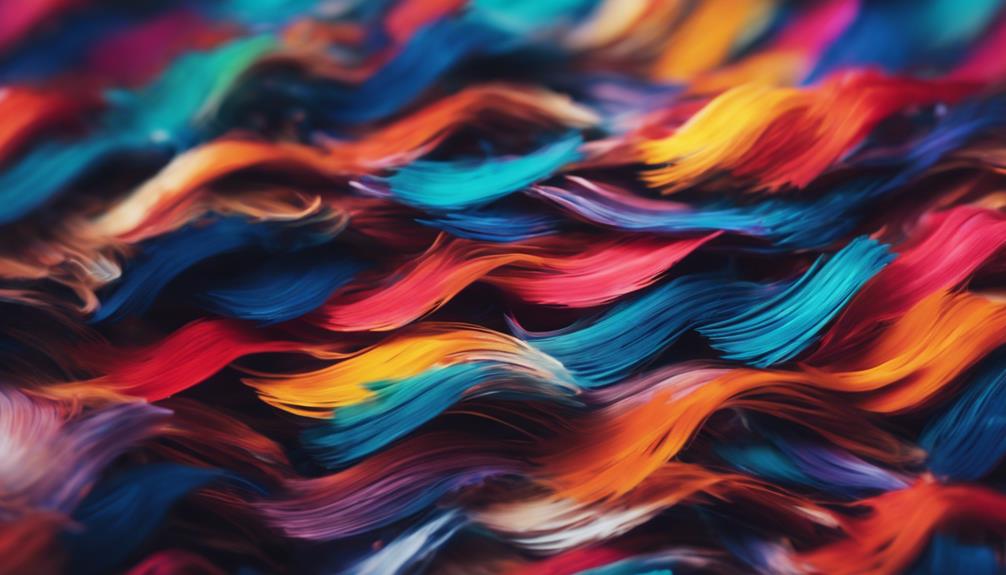
Let's talk about bringing those painted songs to life! Color Symbolism in Art sets the stage, creating a visual language that speaks volumes without saying a word.
Composition and Balance are like the rhythm section of our visual representation, keeping everything in sync, while Imagery and Emotions add that special sauce, stirring up feelings that dance off the canvas.
Let's paint a masterpiece that not only sings but also shines with the vibrancy of our creativity!
Color Symbolism in Art
Envision this: red igniting fiery passions, orange smoothly dancing with high-quality vibes, yellow radiating sun-kissed vitality, green whispering calming serenity, and blue painting a tranquil oasis.
Red brings the heat, orange keeps it smooth, yellow shines bright, green chills us out, and blue soothes our souls. It's like a visual symphony where each color plays an essential note in the artwork's melody.
Composition and Balance
When considering visual representation, the key lies in mastering composition and balance to create a harmonious and impactful artwork. Imagine a symphony where each color plays a note, and the canvas dances to their tune. To help you visualize this concept, let's paint a picture using our color palette. Check out the table below to see how we can use red for fire, orange for smoothness, energy for vitality, green for calmness, and blue for serenity. By blending these colors with finesse and strategic placement, we can compose a visual masterpiece that not only pleases the eye but also stirs the soul. So, grab your brushes and let's harmonize our colors into a melodic artwork!
| Color | Representation |
|---|---|
| Red | Fire |
| Orange | Smoothness |
| Yellow | Energy |
| Green | Calmness |
| Blue | Serenity |
Imagery and Emotions
Mastering composition and balance in visual art sets the foundation for effectively conveying emotions and creating impactful imagery.
We can use warm colors like red and orange to ignite feelings of energy and passion, bringing that fiery intensity to our visual representation. Adding bright yellow hues will inject a sense of vitality and positivity, making our imagery pop with life.
And don't forget about the calming green tones that nurture the soul and promote growth, giving our art a peaceful vibe. By incorporating serene blue shades, we can induce relaxation and tranquility, turning our visual representation into a soothing oasis.
Experimenting with different color combinations and techniques allows us to tailor our art to evoke specific emotions and harmonize with the song's melody perfectly.
Enhancing Music Appreciation

Imagine this: you're listening to your favorite tune, and suddenly, a burst of vibrant colors floods your mind, enhancing every note and beat. Colors aren't just pretty; they can represent the emotions and vibes of a song, adding layers to your auditory journey. For those with synesthesia or visual learners, connecting colors to music can be a game-changer, turning a regular listening session into a full-blown sensory fiesta.
Visual harmony isn't just about making things look pretty; it's about elevating the mood and atmosphere of a song. Envision a sunset painted with the hues of a melancholic melody – it's like your ears and eyes are having a dance party together! By adding colors to the mix, you engage with music on a whole new level, making each listening experience unforgettable. So, next time you're jamming out to your favorite track, why not let your imagination run wild and paint a rainbow of emotions with every beat?
Benefits of Visual Harmony

Engaging multiple senses through visual harmony enhances the overall listening experience, creating a deeper connection to the music. Visual harmony isn't just about making things look pretty; it's like adding a sprinkle of magic to your favorite tune! Here are some benefits of visual harmony that will make you want to grab a paintbrush and start creating:
- Evoking Emotions: Visual elements can help set the mood and evoke specific feelings that complement the music, making the listening experience richer and more impactful.
- Enhanced Engagement: Creating visual harmony can turn a regular performance into a spellbinding show, leaving the audience mesmerized and wanting more.
- Unified Experience: By tying together different elements like colors, shapes, and textures, visual harmony provides a seamless and cohesive experience for the audience, enhancing the overall presentation.
- Conveying Messages: Visual harmony can be a powerful tool to convey the artist's message or story more effectively, adding layers of meaning and depth to the music.
- Memorable Impressions: A harmonious visual presentation can leave a lasting impression on the audience, making the music more memorable and enjoyable.
Creating Personalized Artwork

In personalizing artwork inspired by music, we blend colors representing various musical elements to enhance the visual representation. By incorporating shades like red for fire, orange for liveliness, and green for calmness, we create a personalized piece that harmonizes with the melody in a visually stimulating way.
| Musical Element | Color Representation | Effect on Artwork |
|---|---|---|
| Fire | Red | Adds a hot flow and glowing effect to the artwork |
| Smoothness | Orange | Maintains a fine quality and keeps the vibe lively |
| Calmness | Green | Signifies tranquility and nurtures the soul |
Mixing these colors thoughtfully can evoke the essence of the music and infuse it into the artwork, creating a unique and personalized visual interpretation of the song's emotions and rhythms. So, grab your paintbrush and let's blend some musical magic onto the canvas!
Exploring Cross-Sensory Experiences
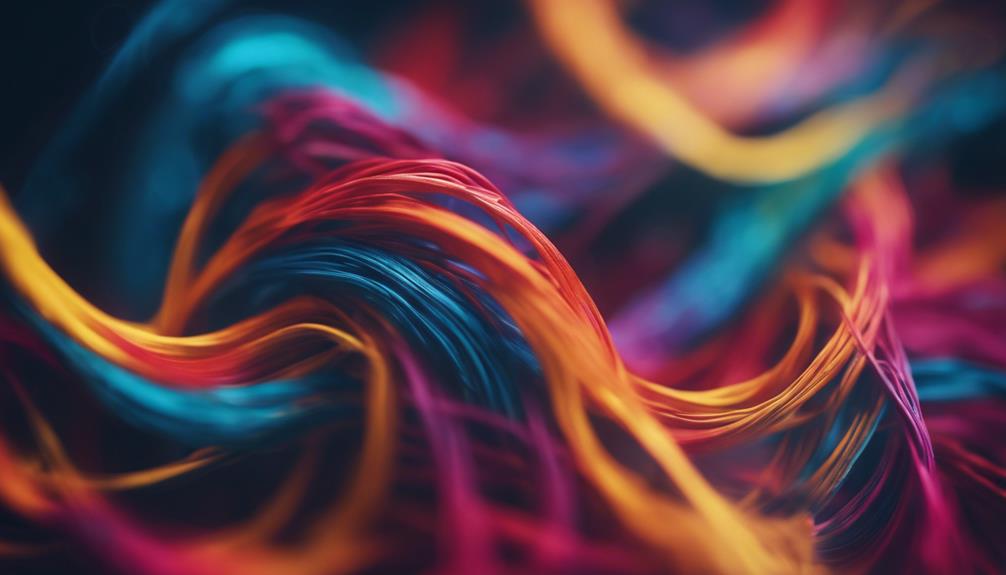
As we explore auditory and visual cues, we uncover new dimensions in music appreciation through cross-sensory experiences. It's like adding sprinkles to your ice cream – it just amplifies the whole experience! Here are some cool things about exploring these cross-sensory connections:
- Visual elements like color can totally change how we feel about a song. It's like giving your music a whole new outfit to wear!
- Ever heard of synesthesia? It's when your senses overlap, so you might see colors when you hear music. Talk about a wild journey of creativity!
- When we create visual representations of music, it's like drawing a map of the melody. Suddenly, you're not just listening – you're seeing and feeling the music too!
- Mixing colors, shapes, and textures with music is like creating a whole new world to immerse into. It's like a mini-vacation for your senses!
- So, next time you're jamming out to your favorite song, why not close your eyes and let the music paint a picture in your mind? Who knows what masterpiece you might discover!
Frequently Asked Questions
How Can You Show Harmony in Your Painting?
To show harmony in our painting, we mix complementary colors for a vibrant pop!
We balance our composition and play with symmetry to keep things visually pleasing.
Adding different textures and patterns gives our artwork depth and richness.
We're all about setting the right mood and atmosphere, so light and shadow play a big role in creating that perfect balance.
It's all about creating a cohesive and harmonious masterpiece that sings!
What Is the Connection Between Music and Painting?
The connection between music and painting is like a secret dance between colors and sounds, each one influencing and inspiring the other.
When we immerse ourselves in a piece of music or a painting, we're not just seeing or hearing; we're feeling the emotions and stories woven into every note or stroke.
It's a beautiful fusion of creativity that transcends boundaries, allowing us to experience art in a whole new light.
What Are the Similarities Between Art and Music?
When it comes to art and music, the similarities are mind-blowing!
Both let us express ourselves without saying a word, requiring mad skills and creativity to hit that sweet spot of harmony.
Plus, they're like besties inspiring each other all the time, leading to epic collabs that mix visuals and sounds in wicked ways.
It's crazy how art and music can bring people together, crossing cultures and languages with their rad vibes.
What Does Harmonious Mean in Art?
When we talk about harmony in art, we're basically chatting about how everything looks all nice and balanced. It's like putting together a killer outfit that just screams 'I got style!'
Harmonious art nails that perfect combo of colors, shapes, and textures that make our eyes go, 'Wow, that's pleasing!' Artists use fancy tricks like color theory and design principles to create this visual magic that gives us all the warm fuzzies.
Conclusion
To sum up, painting a song can truly enhance our music experience by adding a splash of visual harmony. By mapping colors to melodies and creating personalized artwork, we can immerse ourselves in a world of cross-sensory experiences that amplify our emotional connection to music.
So next time you're listening to your favorite tune, why not grab a brush and let your creativity flow? Let's harmonize melodies with colors for a symphony of sights and sounds!
Music Career Tips
Creating a Musical Medley in 3 Simple Steps
Keen to craft a captivating musical medley? Uncover the secrets to seamless song selection and transitions in just three steps – ready for the musical journey ahead?

Hey there, all set to mix your favorite tunes into a groovy musical medley? Let's jump in! First off, cherry-pick songs that vibe together like two peas in a pod. Look for common threads in theme, style, or mood to keep the flow smooth. Next, line up your playlist in a smart order; think of it as creating a music puzzle – each piece fits just right. To wrap things up, nail those shifts by prepping your audience for key changes and using fancy techniques like the two-five progression. Intrigued? Keep exploring for more melody-mixing magic!
Key Takeaways
- Select songs with common themes, styles, or moods for coherence.
- Plan a logical sequence for smooth transitions between songs.
- Use chord progressions to prepare for key changes.
- Implement techniques like the two-five progression for harmonious shifts.
- Continuously explore and experiment to find the perfect medley mix.
Selecting Complementary Songs
How do we guarantee coherence in a musical medley through song selection?
Well, it's all about making sure those songs work harmoniously together like a well-oiled machine. Imagine each song is a gear, and we need to choose ones that mesh perfectly to keep the medley running smoothly. This means selecting tunes that share a common theme, style, or mood. When these songs come together, they should feel like they belong in the same musical universe.
When picking songs for your medley, consider the tempo changes and different styles. You don't want a jarring shift that leaves your listeners feeling like they're on a musical rollercoaster. Aim for those smooth progressions that flow effortlessly from one song to the next.
Think of it as telling a cohesive story through music. Each song is a chapter, and together they create a balanced narrative that keeps your audience engaged from start to finish. So, let's mix and match those tunes with finesse, creating a musical blend that's as satisfying as a perfectly crafted smoothie.
Organizing Song Sequence

When crafting a musical medley, the sequence of songs plays an important role in maintaining coherence and flow throughout the performance. So, what's the plan here? Well, first things first, you gotta figure out where you're gonna move from one song to the next. It's like a musical road trip – the journey matters as much as the destination.
Next song on the list? Tempo changes! You don't want your audience feeling like they're on a rollercoaster without a seatbelt, right? Make those shifts smooth like butter on a hot pan.
Now, about that logical sequence – think of it as putting together a puzzle. Each piece (or song) should fit just right to create the bigger picture. Consider mood variations – you don't wanna go from a party anthem to a tearjerker without warning.
And hey, those narrative connections? They're like the glue holding your medley together, creating a cohesive experience that leaves your audience wanting more. Experiment with different song combinations until you find that perfect harmony. Trust us, it's worth it!
Implementing Smooth Transitions
To guarantee a smooth shift between songs in a medley, incorporating chord progressions that prepare listeners for key changes is vital. When journeying through a musical blend of different tunes, the connections play a pivotal role in maintaining the flow and keeping the audience engaged. Here are some innovative techniques to secure seamless shifts between songs:
- Playing the five chord of the upcoming song helps set the stage for the imminent key change, signaling to the listeners that a new musical adventure is about to unfold.
- Shifting with the tonic chord of the key as a sixth chord acts as a bridge between songs, providing a sense of continuity and cohesion in the medley.
- Utilizing the two-five progression leading into the next key creates a smooth and harmonious shift, guiding the listeners effortlessly from one song to the next.
- Vamping between the tonic chord and a chord one whole step below can add a touch of suspense and anticipation, creating a dynamic shift that keeps the musical experience exciting.
- These shift techniques are like musical magic tricks, weaving together different songs into a cohesive and enthralling medley that elevates the overall musical experience.
Frequently Asked Questions
How Do You Make a Medley?
When making a medley, we fuse songs seamlessly to tell a musical story. It's all about connecting tunes like puzzle pieces, ensuring smooth shifts keep toes tapping.
By mixing tempos, keys, and styles, we create a catchy blend that surprises and delights. Practice makes perfect, as we refine our medley until it shines.
What Is a Medley in Music Examples?
When we talk about a medley in music, we're basically blending different songs seamlessly, creating a musical mashup that's like hitting shuffle on your favorite tunes.
It's like a DJ mixtape of awesomeness, where songs flow into each other, creating a unique listening experience.
Think of it as a musical rollercoaster, taking you on a ride through various melodies and rhythms without missing a beat.
It's like a buffet of music, serving up a little bit of everything for your ears to feast on.
What Is a Musical Medley?
A musical medley is like a delicious buffet of tunes, a mixtape masterpiece where songs mingle and dance together in perfect harmony.
It's the ultimate musical mashup, blending melodies and rhythms seamlessly. With clever shifts and key changes, we weave a story with songs, taking listeners on a journey through different styles and emotions.
How Many Makes a Medley?
Well, folks, when it comes to the age-old question of 'how many makes a medley,' the answer isn't as clear-cut as counting sheep in a dream.
A medley can range from a duo to a whole bouquet of tunes, depending on the maestro's fancy. It's all about weaving those melodies together like a musical tapestry.
Conclusion
So there you have it, folks! With just a few simple steps, you can create a musical medley that will have everyone singing and dancing along.
Remember to choose songs that complement each other, organize them in a sequence that flows smoothly, and use segues to make the medley seamless.
Get ready to wow your audience with your musical mixtape skills!
-

 Music Career Tips4 months ago
Music Career Tips4 months agoHow to Play Songs in Gorilla Tag
-

 Music Career Tips4 months ago
Music Career Tips4 months agoHow to Send Songs on Messenger in 10 Easy Steps
-

 Music Career Tips4 months ago
Music Career Tips4 months ago10 Steps to Display Song Names on Your Car Radio
-

 Music Career Tips4 months ago
Music Career Tips4 months agoDiscover Similar Music to Your Favorites: Finding Songs Like Other Songs
-

 Music Career Tips4 months ago
Music Career Tips4 months agoHow to Turn Songs Into Piano Notes in 10 Steps
-

 Music Career Tips4 months ago
Music Career Tips4 months ago5 Easy Steps to Loop Songs on SoundCloud via Xbox
-

 Music Career Tips4 months ago
Music Career Tips4 months agoHow to Find Your Pre Saved Songs on Spotify in 5 Steps
-

 Music Career Tips4 months ago
Music Career Tips4 months agoCreating a Musical Medley in 3 Simple Steps
